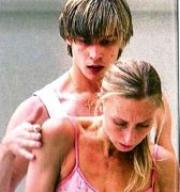Kim Brandstrup
Mentoring

Mentoring
Kim Brandstrup has taught choreograhpy and has worked as a mentor for a number of young choreographers. He refers to his mentoring as the ideal framework for artistic reflection and theoretical clarification - as a place of mutual learning .
He ran a mentoring programme with Arc Dance Company for professional choreographers(2001-2005), he was mentor for the winners of the Peter Darell Choreographic Competion( 2000-2002) , founded with Deborah Bull the ‘Dancelines’ choreographic summer course at ROH and ran the first three courses . He is currently mentor for Rambert Dance Company's Workshop.
Mentoring Projects
DanceLines 2007 Before the Act : Motion impulse and movement imagination.
ROH2
Royal Opera House Covent Garden , August 2007
"This years DanceLines are directed towards choreographers that comes from a classical background and primarily works in a classical language.Where former years discussions have evolved around different compositional strategies especially structure and the relation between dance and music ; this years course is addressing a group of creators for whom structure and musical form is deeply imbedded in the their classical training- is second nature.
The course will as its starting point focus on the the creative impulse in its raw state, before it takes form or requires a structure, the idea of an 'impulse' , the impulse to move before we move. What is there before preconceived ideas of form, shape , syllabus or codified steps . How do we “think” movement, how do we visualise motion without something moving, can we imagine dance without a moving body. Does such a thing as a movement imagination exist ."
DanceLines 2006 Structure: Inside-out/Outside-in
ROH2
Royal Opera House Covent Garden , July 2006
This years course is called 'Structure - inside-out/outside-in'. Unlike in architecture and visual arts where structure both refers to visible and even tactile surface as well as foundation and ground, in dance structure is only 'sensed' , it is invisible, neither solid nor tangible. In dance ( as in music, film and performed drama) the structural element disappear into the past at the same rate as the piece reveals itself.
Dance has for as long as it has been a theatrical artform borrowed formal and structural prodedures from especially music and drama. We will look at these and influences from other artforms, but we will also look at structure from a more foundmental point of view : our brains ability and inclination to structure in time, creating seqences and patterns of events, anticipating frequency of occurences.
DanceLines 2005 Motion Heard: Dance and Music Synerg
ROH2
Royal Opera House Covent Garden , September 2005
The notion that dance and music are inseparably linked has been challenged throughout the twentieth century. From early modern dance which created movement and dance first and subsequently composed the score, through to the chance-generated co-existence of sound and movement, each new challenge sought to free dance from subservience to the music.
Some of these strategies have been invaluable in freeing us from habitual and imitative responses to music. But dance and music share a long history and in spite of our attempts to explore the limits of this relationship, for many (most?) choreographers music is what comes first. It is what makes us dance. Makers and spectators still marvel at the embodied musicality of the dancer, his or her rhythmical precision and phrasing. Certain choreographers including Balanchine, Ashton, and Mark Morris are hailed for their innate musicality.
With both recent and longer-term history in mind, this course will explore ‘musicality’ and a number of
different strategies for the use of music drawn from a range of cultural sources including Indian dance,
19th century Western musical composition as well as contemporary rhythmical driven music. To encourage as well as expand the use of music in our dance making, 5 choreographers and a group of musicians from different backgrounds will engage over two weeks in a practical dialogue of both research and creation."
